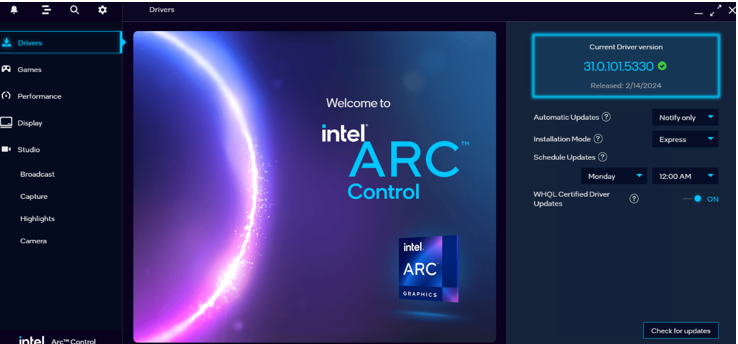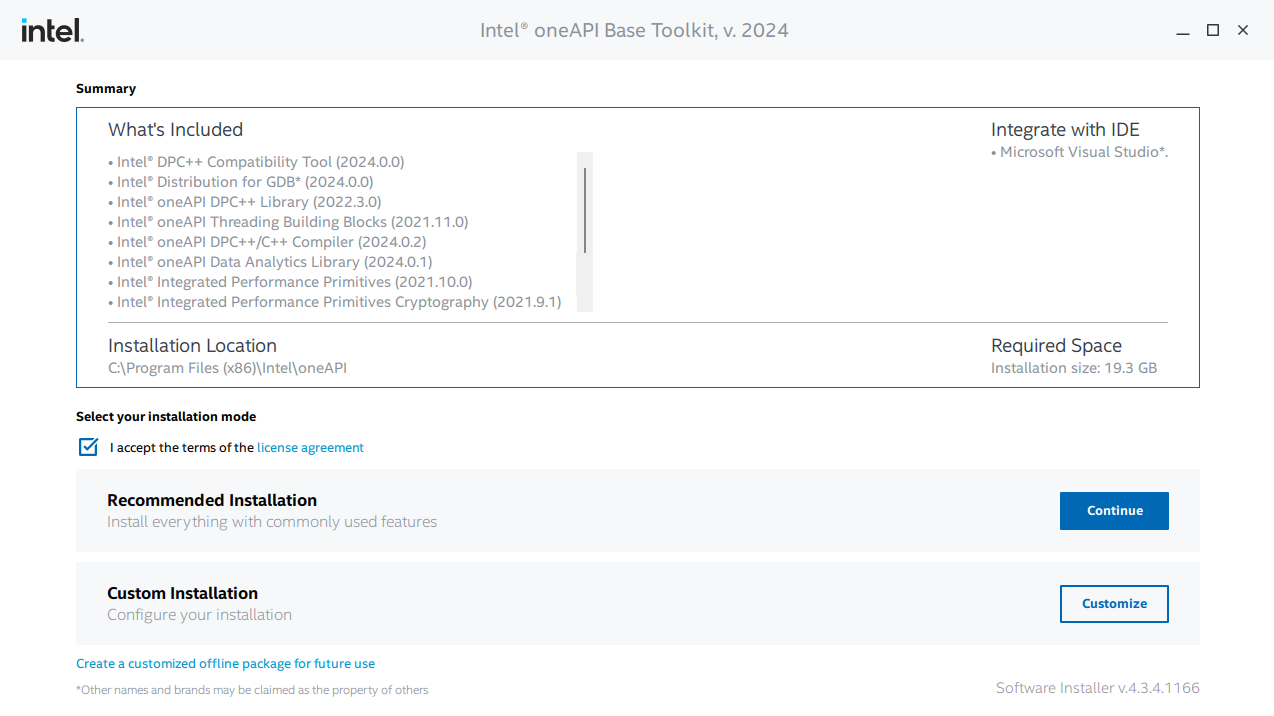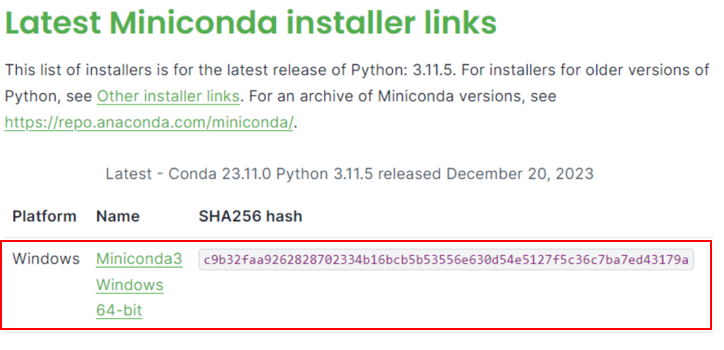8 KiB
Install BigDL-LLM on Windows with Intel GPU
This guide demonstrates how to install BigDL-LLM on Windows with Intel GPUs.
It applies to Intel Core Ultra and Core 12 - 14 gen integrated GPUs (iGPUs), as well as Intel Arc Series GPU.
Install Visual Studio 2022
-
Download and Install Visual Studio 2022 Community Edition from the official Microsoft Visual Studio website. Ensure you select the Desktop development with C++ workload during the installation process.
Note: The installation could take around 15 minutes, and requires at least 7GB of free disk space. If you accidentally skip adding the Desktop development with C++ workload during the initial setup, you can add it afterward by navigating to Tools > Get Tools and Features.... Follow the instructions on this Microsoft guide to update your installation.

Install GPU Driver
-
Download and install the latest GPU driver from the official Intel download page. A system reboot is necessary to apply the changes after the installation is complete.
Note: The process could take around 10 minutes. After reboot, check for the Intel Arc Control application to verify the driver has been installed correctly. If the installation was successful, you should see the Arc Control interface similar to the figure below

-
To monitor your GPU's performance and status, you can use either the Windows Task Manager (see the left side of the figure below) or the Arc Control application (see the right side of the figure below) :

Install oneAPI
-
Download and install the Intel oneAPI Base Toolkit. During installation, you can continue with the default installation settings.

Setup Python Environment
-
Visit Miniconda installation page, download the Miniconda installer for Windows, and follow the instructions to complete the installation.

-
After installation, open the Anaconda Prompt, create a new python environment
llm:conda create -n llm python=3.9 libuv -
Activate the newly created environment
llm:conda activate llm
Install bigdl-llm
-
With the
llmenvironment active, usepipto installbigdl-llmfor GPU: Choose either US or CN website forextra-index-url:- US:
pip install --pre --upgrade bigdl-llm[xpu] --extra-index-url https://pytorch-extension.intel.com/release-whl/stable/xpu/us/ - CN:
pip install --pre --upgrade bigdl-llm[xpu] --extra-index-url https://pytorch-extension.intel.com/release-whl/stable/xpu/cn/
Note: If you encounter network issues while installing IPEX, refer to this guide for troubleshooting advice.
- US:
-
You can verfy if bigdl-llm is successfully by simply importing a few classes from the library. For example, in the Python interactive shell, execute the following import command:
from bigdl.llm.transformers import AutoModel,AutoModelForCausalLM
A Quick Example
Now let's play with a real LLM. We'll be using the phi-1.5 model, a 1.3 billion parameter LLM for this demostration. Follow the steps below to setup and run the model, and observe how it responds to a prompt "What is AI?".
-
Step 1: Open the Anaconda Prompt and activate the Python environment
llmyou previously created:conda activate llm -
Step 2: Configure oneAPI variables by running the following command:
For more details about runtime configurations, refer to this guide:
call "C:\Program Files (x86)\Intel\oneAPI\setvars.bat"If you're running on iGPU, set additional environment variables by running the following commands:
set SYCL_CACHE_PERSISTENT=1 set BIGDL_LLM_XMX_DISABLED=1 -
Step 3: To ensure compatibility with
phi-1.5, update the transformers library to version 4.37.0:pip install -U transformers==4.37.0 -
Step 4: Create a new file named
demo.pyand insert the code snippet below.# Copy/Paste the contents to a new file demo.py import torch from bigdl.llm.transformers import AutoModelForCausalLM from transformers import AutoTokenizer, GenerationConfig generation_config = GenerationConfig(use_cache = True) tokenizer = AutoTokenizer.from_pretrained("microsoft/phi-1_5", trust_remote_code=True) # load Model using bigdl-llm and load it to GPU model = AutoModelForCausalLM.from_pretrained( "microsoft/phi-1_5", load_in_4bit=True, cpu_embedding=True, trust_remote_code=True) model = model.to('xpu') # Format the prompt question = "What is AI?" prompt = " Question:{prompt}\n\n Answer:".format(prompt=question) # Generate predicted tokens with torch.inference_mode(): input_ids = tokenizer.encode(prompt, return_tensors="pt").to('xpu') # warm up one more time before the actual generation task for the first run, see details in `Tips & Troubleshooting` # output = model.generate(input_ids, do_sample=False, max_new_tokens=32, generation_config = generation_config) output = model.generate(input_ids, do_sample=False, max_new_tokens=32, generation_config = generation_config).cpu() output_str = tokenizer.decode(output[0], skip_special_tokens=True) print(output_str)Note: when running LLMs on Intel iGPUs with limited memory size, we recommend setting
cpu_embedding=Truein thefrom_pretrainedfunction. This will allow the memory-intensive embedding layer to utilize the CPU instead of GPU. -
Step 5. Run
demo.pywithin the activated Python environment using the following command:python demo.pyExample output
Example output on a system equipped with an 11th Gen Intel Core i7 CPU and Iris Xe Graphics iGPU:
Question:What is AI? Answer: AI stands for Artificial Intelligence, which is the simulation of human intelligence in machines.
Tips & Troubleshooting
Warmup for optimial performance on first run
When running LLMs on GPU for the first time, you might notice the performance is lower than expected, with delays up to several minutes before the first token is generated. This delay occurs because the GPU kernels require compilation and initialization, which varies across different GPU models. To achieve optimal and consistent performance, we recommend a one-time warm-up by running model.generate(...) an additional time before starting your actual generation tasks. If you're developing an application, you can incorporate this warmup step into start-up or loading routine to enhance the user experience.